Gigabyte Q1585M, Q1585N User Manual [ru]
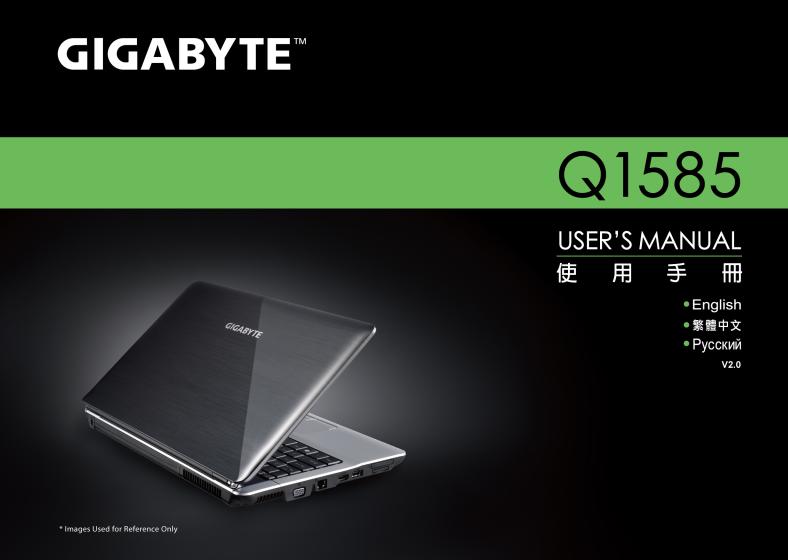
Copyright © 2010 GIGABYTE TECHNOLOGY CO., LTD.
All Rights Reserved
GIGABYTE Q1585 Series Notebooks User’s Manual
Date Issued: 2010/04
This manual takes you, step by step, through setting up and using your new Notebook PC. Information in this manual has been carefully checked for accuracy and is subject to change without prior notice.
No part or parts of this manual may be reproduced, stored in a retrieval system, or transmitted, in any form or by any means, electronic, mechanical, by photocopy, recording, or otherwise, without prior written consent.
Trademarks
Product names used herein are for identication purposes only and may be the trademarks of their respective companies. Microsoft® , MS-DOS, Windows® , and Windows® Sound System are trademarks of the Microsoft Corporation.
Intel® & Atom™. are registered trademarks of Intel Corporation.
Sound Blaster & Sound Blaster Pro are trademarks of Creative Technology.
All other brands or product names mentioned in this manual are trademarks or registered trademarks of their respective companies.

English
I
General Safety Precautions
In order to ensure your safety and the safety of you notebook, we ask that your carefully follow these safety precautions.
CAUTION: Using your notebook for long periods of time, with the base resting directly on exposed skin, can cause injury, burns or discomfort from the heat buildup that is generated from the base of your portable computer.
●After removing the notebook from the box, please ensure that all packaging materials are kept out of the reach of small children as they can cause a potential choking hazard. The packaging materials should be safely stored away in the event that it may be used again for safe transportation of the notebook.
●Ensure that the AC Adapter and power cable are placed in a safe area where it cannot be tripped over or stepped on. The AC Adapter should be situated in a well ventilated area and should have nothing resting on or covering it.
●Before turning on the notebook, ensure that it is placed on a level surface with at least 10 cm of clearance around the air vents, which will aid in proper cooling.
●Do not obstruct the air vents of the notebook and do not insert any foreign objects into this space. Doing this may cause a short circuit or may cause the CPU fan to malfunction, resulting in the risk of a fire or electric shock. This may eventually render permanent damage to the notebook.
●Do note press or touch the display panel.
●Only use the AC Adapter that is provided with the notebook or
that which is recommended by the manufacturer. Using nonrecommended or non-approved parts may cause damage or increase the risk of a fire or explosion. In the event that another AC Adapter is required, advice should be sought from a GIGABYTE service agent, in order to make sure that the correct part is recommended.
●Please follow the battery installation guidelines. Incorrect installation of batteries may increase the risk of a fire or explosion.
●Only replace old batteries with the same or an alternative compatible battery that is recommended by GIGABYTE or an authorized GIGABYTE Service Centre.
●Before connecting the notebook to the power outlet, make sure that the voltage rating of the AC Adapter is compatible with the power specification in the country where you are located. A detailed list of the power specification for different countries can be found on page 23.
●When using an extension cord, please make sure that the total sum of ampere ratings for all connected devices does not exceed the total ampere capacity for the circuit.
●Before removing the battery from the notebook, make sure firstly that the notebook is switched off and secondly that the AC Adapter is disconnected from the electrical wall socket. Once this is done, it would be safe to remove the battery.
Do not carry the notebook battery, loose, in your handbag, backpack or pocket where loose metal objects (money, keys, chains, pens, etc) may be present. The metal objects can short circuit the terminals of the battery resulting in overheating that could cause a fire hazard. In the event that you need to
transport the battery separately from the notebook, please place it inside an anti-static bag.

●Discard old worn out batteries according to the instructions on Page VI. Never throw batteries into a fire as this can cause an explosion.
●Never attempt to repair or service the notebook yourself. Please refer all repairs and servicing to qualified service personnel at a GIGABYTE Authorized Service Centre.
Travel Tips
Although notebooks are designed to be as robust as possible to cater for a mobile lifestyle, extreme care and caution should be taken when travelling. When travelling by land, sea or air, every precaution should be taken to make sure that the notebook is well secured when it is not in use.
●The most essential accessory you should have when travelling is a good carry case for your notebook. The case should be well padded to protect your notebook from drops and bumps, etc and should be big enough to hold the size of notebook.
●Make sure there is enough room to carry your AC Adapter and spare battery etc. Only carry the necessary items in your carry case, as the weight can become tedious especially when walking long distances or waiting in long queue’s.
●When travelling by air, never book your notebook with checked baggage. Always declare it as hand baggage so that you can carry it into the airplane cabin with you. Most airlines allow two pieces of hand baggage with one of them being a bag or carry case with a portable notebook. Please consult your local airline for more details.
●When placing your notebook on an X-Ray, make sure that you keep a close eye on it when it is on the conveyor belt. Hold on to your
Q1585 SERIES USER’S MANUAL
notebook until the last minute before placing it on the conveyor. In some airports it could be stolen while you are stuck in a queue waiting to pass through the metal detector.
●Notebooks and hard drives can pass through X-Ray machines but never allow these to pass through a metal detector. This can cause data loss to the hard drive.
●Never place your notebook in the overhead storage compartment as this can make it susceptible to damage caused by turbulence that may be experienced during the flight or in other case theft. You can store your notebook under your seat, where it is always in sight.
●You should take every precaution to protect your notebook from dust, dirt, liquid spillage, food droppings, extreme weather conditions and direct exposure to sunlight.
●When travelling between different climates, from one extreme to another, condensation may occur inside the notebook. If this does happen, please allow sufficient time for the moisture to evaporate completely, before attempting to switch on.
●When travelling from extremely colder to extremely warmer climates in a short space of time, and vice versa, please allow the notebook some time to adapt to the change in environment.
Usage Tips
●When unplugging the power connector from the notebook, please hold and pull on the connector or the strain relief loop to disconnect. Do not pull the power cord itself as this can cause damage to the cable or the notebook.
●In the event of an electrical storm, please disconnect the notebook from the power source and unplug any network or telephone cables that may be connected to the notebook.
English
II

English
III
●Do not use the notebook near water sources, like bathtubs, washing basins, kitchen or laundry sinks or swimming pools. Liquid that can spill onto the notebook by accident can cause electric shock to you and damage to the notebook.
Cleaning Tips
When cleaning the notebook, please make sure that the notebook is switched off and disconnected from the power source and that the battery is removed.
Notebook Cover:
Use a microfiber or lint free soft cotton cloth and kitchen detergent (mix 5 parts water to 1 part detergent).
●Wet the cloth and wring out all excess liquid and wipe the surfaces clean.
●Take extra care to make sure that the cloth is damp and not very wet, especially when cleaning around the air vents and other openings as too much liquid in the cloth could drip onto the external components causing damage to the notebook.
●Do not clean the keyboard with this liquid.
Keyboard:
●It is advisable to use a can of compressed air to clean debris that maybe caught underneath the keys.
●Isopropyl alcohol can be used to clean the keys by dipping a lintfree soft cloth into it, wringing out the excess liquid and wiping the keys.
●Allow to dry for at least 5 minutes.
LCD:
●It is best to use a microfiber cloth to clean the surface of the LCD.
●If there are any marks or stains present, it would be wise to use commercially available LCD cleaning kit. When using a commercially available LCD cleaning kit, never spray the liquid directly onto the screen. You must spray it onto the cleaning cloth and then wipe the screen clean.
●If this is not available then you can mix 50% isopropyl alcohol and 50% distilled water to clean the surface of the LCD screen.
●Dip the lint free soft cotton cloth into the solution, wringing out excess liquid.
●The cloth must be damp but not dripping with liquid.
●Take care not to let any excess liquid drip into the notebook.
●Start from the top of the LCD surface and wipe from side to side.
●Continue with this until the entire LCD surface has been cleaned.
●Wipe the display with a clean, dry lint free soft cotton or microfiber cloth.
●Wait for the LCD surface to dry completely and then close the lid.
Be careful when using Isopropyl Alcohol as this is a flammable liquid. Please keep away from children, naked flames or a notebook that is switched on.

Warranty Guidelines
All warranty repairs and service must be carried out by a GIGABYTE Authorized Repair Centre.
GIGABYTE Limited Warranty
GIGABYTE warrants, that the GIGABYTE branded Notebook/Netbook is free of any defects in materials and workmanship under normal use during the warranty period.
●All GIGABYTE supplied AC adapters and batteries carry a 1 year limited warranty.
●The warranty is effective from date of purchase.
●If proof of purchase cannot be shown, then the warranty will be determined based on the date of manufacture.
●The limited warranty is only valid for GIGABYTE branded or supplied hardware.
●In the event that a defect arises in materials or workmanship and proof is shown of this defect, GIGABYTE will, through its authorized service provider or partner, repair the product at no extra charge, using new or refurbished replacement parts in order to fulfill the warranty obligations.
●If, during the warranty period, GIGABYTE or its service provider is unable to repair the product, the product will be replaced with a comparable product that is new or refurbished.
Q1585 SERIES USER’S MANUAL
Warranty Limitations
The GIGABYTE Limited Warranty does not cover the following…
●Software, including the operating system and applications supplied with the product. This also includes third party software that may be installed after purchase.
●Third party hardware, products and accessories not supplied by GIGABYTE. This also includes third party hardware that may be bundled with the notebook or netbook.
●Products with missing or defaced labels and/or serial numbers
●Products damaged by environmental factors, which include oxidation
●Products damaged by natural disasters or acts of God.
●Physical Damages which include, but not limited to, the following:
►Unauthorized modifications, repairs or servicing
►Misuse, abuse, neglect or failure to follow instructions in the user manual.
►Improper assembly
►Damages caused by transport due to improper packaging or mishandling by the courier company unless transport is part of the warranty conditions in certain countries.
►Electric damage resulting from faulty or failed electric power or power surges.
►Damaged or cracked components
►Liquid damage
English
IV

English
V
Regulatory Notices
Federal Communications Commission Notice
This equipment has been tested and found to comply with the limits for a Class B digital service, pursuant to Part 15 of the FCC rules. These limits are designed to provide reasonable protection against harmful interference in a residential installation.
Any changes or modifications made to this equipment may void the user’s authority to operate this equipment. This equipment generates, uses, and can radiate radio frequency energy. If not installed and used in accordance with the instructions, may cause harmful interference to radio communications. However, there is no guarantee that interference will not occur in a particular installation. If this
equipment does cause harmful interference to radio or television reception, which can be determined by turning the equipment off and on, the user is encouraged to try to correct the interference by one or more of the following measures:
●Reorient or relocate the receiving antenna.
●Increase the separation between the equipment and receiver.
●Connect the equipment into an outlet on a circuit different from that towhich the receiver is connected.
●Consult the dealer or an experienced radio/TV technician for help.
●All external cables connecting to this basic unit must be shielded.
For cables connecting to PCMCIA cards, see the option manual or nstallation instructions.
RF Exposure
This equipment must be installed and operated in accordance with provided instructions and must not be co-located or operating in conjunction with any other antenna or transmitter. End-users and installers must be provide with antenna installation instructions and transmitter operating conditions for satisfying RF exposure compliance.
CE Notice (European Union)
This symbol 
 indicates this Booktop Q1585 notebook complies with the EMC Directive and the European Union’s Low Voltage Directive. This symbol also indicates that Q1585 meets the following technical standards:
indicates this Booktop Q1585 notebook complies with the EMC Directive and the European Union’s Low Voltage Directive. This symbol also indicates that Q1585 meets the following technical standards:
●EN 55022 — “Limitations and Methods of Measurement for the Radio Interferences of Information Technology Equipment.”
●EN 55024 — “Information technology equipment - Immunity characteristics - Limits and methods of measurement.”
●EN 61000-3-2 — “Electromagnetic compatibility (EMC) - Chapter 3: Limits - Section 2: Limits on the harmonic current emissions (Equipment input current up to and including 16 A per phase).”
●EN 61000-3-3 — “Electromagnetic compatibility (EMC) - Chapter 3: Limits - Section 3: Limits on the voltage fluctuations and flicker in lowvoltage power supply systems for equipment with rate current up to and including 16 A.”

NOTE: EN 55022 emissions requirements provide for two classifications
●Class A governs commercial use
●Class B is governs residential use
For CB:
●Only use batteries designed for this computer. The wrong battery type may explode, leak or damage the computer
●Do not remove any batteries from the computer while it is powered on
●Do not continue to use a battery that has been dropped, or that appears damaged (e.g. bent or twisted) in any way. Even if the computer continues to work with a damaged battery in place, it may cause circuit damage, which may possibly result in fire.
●Recharge the batteries using the notebook’s system. Incorrect recharging may make the battery explode.
●Do not try to repair a battery pack. Refer any battery pack repair or replacement to your service representative or qualified service personnel.
●Keep children away from, and promptly dispose of a damaged battery. Always dispose of batteries carefully. Batteries may explode or leak if exposed to fire, or improperly handled or discarded.
●Keep the battery away from metal appliances.
●Affix tape to the battery contacts before disposing of the battery.
●Do not touch the battery contacts with your hands or metal objects.
Q1585 SERIES USER’S MANUAL
Battery Disposal & Caution
The product that you have purchased contains a rechargeable battery. The battery is recyclable. At the end of its useful life, under various state and local laws. It may be illegal to dispose of this battery into the municipal waste stream. Check with your local solid waste officials for details in your area for recycling options or proper disposal.
Danger of explosion if battery is incorrectly replaced. Replace only with the same or equivalent type recommended by the manufacturer. Discard used battery according to the manufacturer’s instructions.
English
VI

English
VII
BSMI Notice (Taiwan Only)
Most Q1585 computers are classified by the Bureau of Standards, Meteorology and Inspection (BSMI) as Class B information technology equipment (ITE).
The symbol above must be attached to the product indicating compliance with the BSMI standard.
Replaceable Batteries
If any equipment is provided with a replaceable battery, and if replacement by an incorrect type could result in an explosion (for example, with some lithium batteries), the following applies:
●if the battery is placed in an operator access area, there shall be a marking close to the battery or a statement in boththe operating and the servicing instructions;
●if the battery is placed elsewhere in the equipment, there shall be a marking close to the battery or a statement in the servicing
instructions.
This marking or statement shall include the following or similar text:
CAUTION
RISK OF EXPLOSION IF BATTERY IS REPLACED
WITH AN INCOMPATIBLE BATTERY TYPE.
DISPOSE OF USED BATTERIES
ACCORDING TO THE INSTRUCTIONS

Q1585 SERIES USER’S MANUAL
Introduction
Congratulations and thank you for purchasing the GIGABYTE notebook computer. This portable notebook computer provides excellent multimedia functionality and is designed to provide you reliable, no fuss computing.
This manual will explain to you, step by step, how to setup and begin using your Q1585. It provides basic configuring, operation, care and troubleshooting guidelines.
English
VIII

English
IX
Content |
|
|
General Safety Precautions............................................................... |
I |
|
Travel Tips........................................................................................ |
II |
|
Usage Tips........................................................................................ |
II |
|
Cleaning Tips................................................................................... |
III |
|
Warranty Guidelines......................................................................... |
IV |
|
Regulatory Notices & Certifications................................................... |
V |
|
Battery Disposal & Caution.............................................................. |
VI |
|
Introduction.................................................................................... |
VIII |
|
Chapter 1 Before You Start |
|
|
1.1 |
Make Sure You Have Everything............................................. |
2 |
1.2 |
Familiarize Yourself with the Computer.................................... |
2 |
1.3 |
Top View................................................................................... |
3 |
1.4 |
Left View................................................................................... |
4 |
1.5 |
Right View................................................................................ |
5 |
1.6 |
Back View................................................................................. |
6 |
1.7 |
Bottom View............................................................................. |
6 |
Chapter 2 Getting Started |
|
|
2.1 |
Power Sources....................................................................... |
10 |
2.2 |
Recharging the Battery........................................................... |
11 |
2.3 |
Starting Your Notebook.......................................................... |
12 |
2.4 |
Status Indicators..................................................................... |
12 |
2.5 |
Using Function Keys............................................................... |
13 |
2.6 |
Using the Touch Pad.............................................................. |
14 |
2.7 |
Memory Module Upgrade....................................................... |
15 |
Chapter 3 GIGABYTE Smart Recovery |
|
|
3.1 |
GIGABYTE Smart Recovery.................................................. |
18 |
Chapter 4 Troubleshooting |
|
|
4.1 |
Identifying the Problem........................................................... |
20 |
4.2 |
GIGABYTE Service Information............................................. |
20 |
Appendix |
|
|
|
Q1585 Specifications.............................................................. |
22 |
|
International Country Voltage................................................. |
23 |
|
Plug Type............................................................................... |
27 |

Q1585 SERIES USER’S MANUAL
|
English |
Chapter 1 Before You Start |
1 |
This chapter provides basic information to help you get started and to use the Q1585 notebook.
Some of the features described herein may not function properly or at all unless used in conjunction with the pre-installed operating system. Any change to the operating system may cause improper function.

English
2
1.1 Make Sure You Have Everything
When you receive your notebook PC, unpack it carefully and check to make sure you have all the items listed below. For a preconfigured model you should have the following:
●GIGABYTE Notebook Computer
●Lithium-Ion Battery
●AC Adapter with Power Cord
●Driver Disc
●Quick Start Guide
Once you have checked and confirmed that your notebook system is complete, read through the following pages to learn about all of your notebook components.
NOTE: Depending on the model you purchased, the actual appearance of your notebook may vary from that shown in
this manual.These images are for illustration purposes.
1.2 Familiarize Yourself with the Computer
Opening The Display Panel
To open the display panel, simply lift the lid up. Use one hand to keep the base of the notebook down firmly, and use the other hand to open the display.The hinges are designed to keep the notebook screen closed without the need for a latch.
When closing it, be sure not to slam the display shut as this can damage the display and notebook.
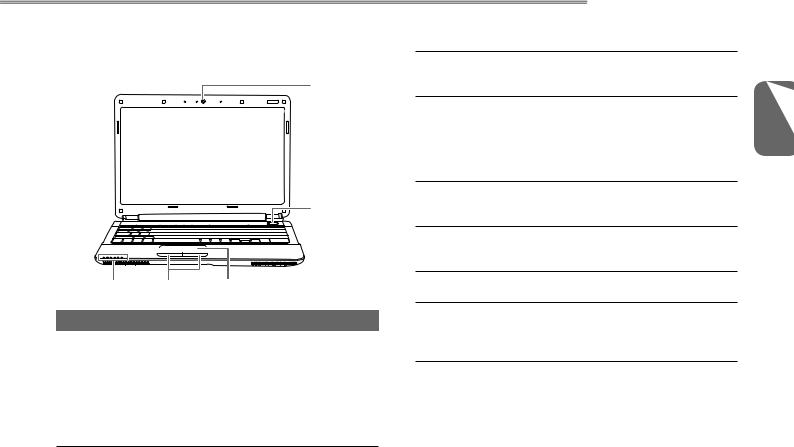
1.3 Top View
The following is an overview of the front of the notebook.
1  2
2  3
3
4









 5
5
|
8 |
7 |
6 |
|
NO. Item |
Function |
|
||
|
|
The built-in 1.3 megapixel camera with 2 |
||
1 |
Webcam |
digital microphones allows you to snap |
||
a photo or create a video or hold a video |
||||
|
|
|||
|
|
conference or chat with just a click. |
||
|
|
|
||
|
|
The built-in microphone allows for the |
||
2 |
Microphone |
reception and transmission of voice and/or |
||
other audio data to any program capable of |
||||
|
|
|||
utilizing the microphone.
Q1585 SERIES USER’S MANUAL
The display panel is a color LCD panel
3LCD Display with back lighting for the display of text and
graphics.
The Status indicator lights correspond to specific operating modes. These modes
4StatusLights Indicator are: Power on / Suspend status, Battery /AC Adapter status, Hard Drive Activity
(HDD), Num Lock, Caps Lock, and Wireless LAN activity.
A full-size keyboard with dedicated
5 Keyboard Windows® keys. The layout will depend on the region you live in.
The touchpad pointing device is a mouse
6Touchpad like cursor control with two buttons and a
touch sensitive movement pad.
7Touchpad The left and right buttons function like the Buttons left and right mouse buttons.
This button turns your notebook on and off
8Power On or puts it to sleep. (See Suspend/Power On Button Button in the Power On section for more
information.)
English
3
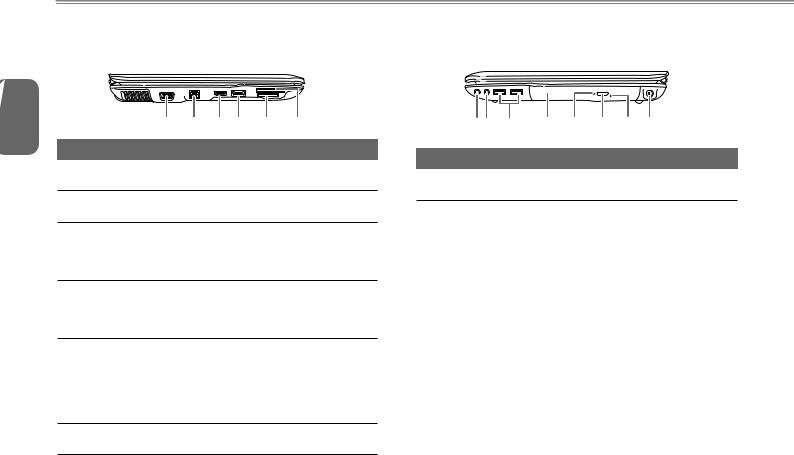
1.4 Left View
The following is a brief description of the left side of the notebook.
English |
|
1 |
2 |
3 |
4 |
5 |
6 |
|
|
||||||
NO. Item |
Function |
|
|
|
|
||
4 |
External |
The external monitor port allows you to |
|||||
1 |
|||||||
|
Monitor Port |
connect an external monitor. |
|||||
2LAN (RJ-45) The LAN port is designed to support a Port 10/100/1000 Base-T standard RJ-45 plug.
The HDMI port allows you to connect a 3 HDMI Port video device such as an HD television,
projector, or HD display to your computer for outputing a high definition signal.
The e-SATA/USB combo port allows you to
4e-SATA/USB connect an external device such as an external combo port hard disk drive or optical drive that use serial
ATAas well as any type of USB device.
The memory card reader offers the fastest and most convenient method to transfer
5Multi Card pictures, music and data between your Reader notebook and flash compatible devices
such as digital cameras, MP3 players, mobile phones, and PDAs.
6Express Card The Express Card Slot allows you to install Slot one Type-II Express Card Slot.
1.5 Right View
The following is a brief description of the right side of the notebook.
1 2 |
3 |
4 |
5 |
6 |
7 |
8 |
NO. Item |
|
Function |
|
|
|
|
1Microphone The microphone jack allows you to connect Jack an external microphone.
2 |
Headphone |
The headphone jack allows you to connect |
|
headphones or external speakers and |
|||
Jack |
|||
|
|
amplifiers. |
|
|
|
The USB port allows you to connect |
|
3 |
USB 2.0 Port |
universal serial bus devices. It supports |
|
v2.0 of the USB standard, which allows |
|||
|
|
||
|
|
data exchange rates as high as 480 Mb/s. |
|
|
|
|
|
4 |
Optical Disc |
The optical drive allows you to play back |
|
and write media discs such as CDs & |
|||
Drive |
|||
|
|
DVDs. |
|
|
Optical Drive |
This light flickers to indicate activity when |
|
5 |
Activity |
the ODD is playing a media disc or is being |
|
|
Indicator |
accessed by the operating system. |

Optical Disc The optical drive eject button allows you
6Drive Eject to open the optical drive tray to remove or
Button |
insert a CD,DVD or BD. |
The emergency tray release allows you to 7 EmergencyRelease Tray open the optical drive tray without powering
on your notebook or in an emergency.
The power adapter port allows you to plug
8Power Adapter in the AC adapter to power your notebook
Port and charge the internal Lithium-Ion battery.
Only use certified AC adaptors.
Q1585 SERIES USER’S MANUAL
1.6 Back View
The following is an overview of the back of the notebook.
Kensington Lock Slot
Kensington Lock Slot
The Kensington lock slot allows you to secure your notebook to an immovable object with an optional security cable.
English
5
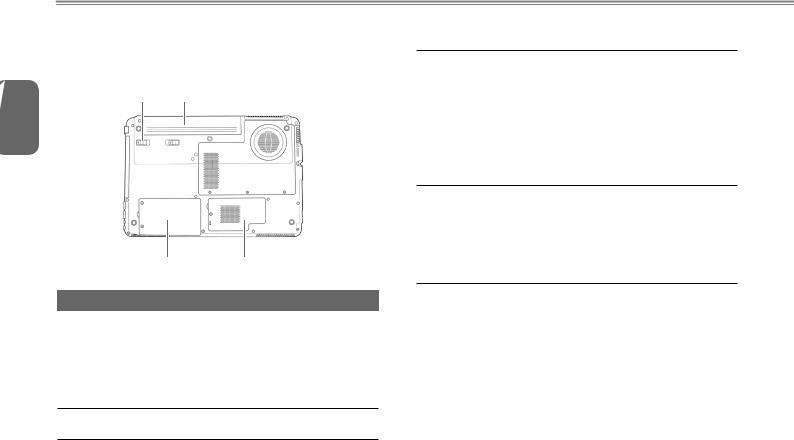
English
6
1.7 Bottom View
The following is an overview of the bottom of the notebook.
2 1
 6
6  5
5
3 4
NO. Item |
Function |
The battery bay contains the internal Lithium-Ion battery. It can be unlatched for the removal of the battery when stored
1Battery Bay over a long period of time or for swapping
a discharged battery with a charged Lithium-Ion battery, and latched in place again.
2 |
Battery Release |
Release the battery for removal. |
Latch |
HDD |
The HDD compartment contains the |
|
3 Compartment |
||
computer's hard disk drive. |
||
Cover |
||
|
||
WiFi |
The Wi-Fi compartment contains the |
4Compartment Wireless LAN card (Not available in all
Cover |
configurations). |
|
RAM |
The memory compartment contains the |
|
5 Compartment |
||
computer's memory modules. |
||
Cover |
||
|
These are open vents for the fan to dissipate heat from the computer's internal components. Do not block these or place
6Cooling Vents the computer in such a position that you
inadvertently allow the outlets to become blocked. Do not cover the vents or place any object into or over the vents.

Q1585 SERIES USER’S MANUAL
Chapter 2 Getting Started
This chapter will show you the various ports and components of the Q1585 and familiarizes you with the notebook. Certain parts of the notebook can be user upgraded while others are fixed and cannot be changed.
English
7
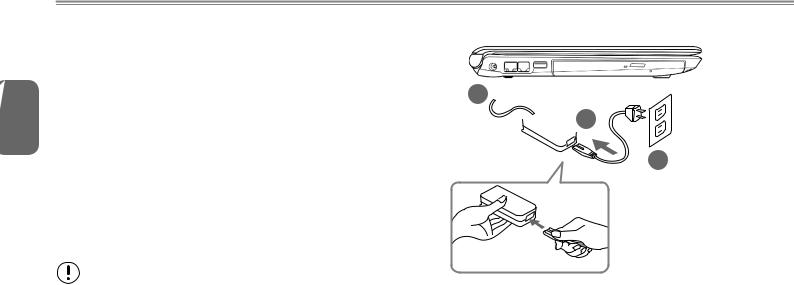
English
8
2.1 Power Sources
Your computer has two types of power sources: a Lithium-Ion battery and an AC adapter.
Connecting the Power Adapters
The AC adapter provides power for operating your notebook PC as well as charging the battery.
Connecting the AC Adapter
1.Plug the DC output cable into the DC power jack of your.
2.Plug the AC adapter into an AC electrical outlet.
Switching from AC Adapter Power to Battery Power
1.Be sure that you have at least one charged battery installed.
2.Remove the AC adapter. Your notebook will automatically switch from DC power to battery power.
CAUTION: The Lithium-Ion battery does not ship with a precharge initially. You will need to connect the AC adapter to useyour notebook PC the first time.
It is recommended that only the AC adapter supplied with the Q1585 is used. Any other adapter could cause damage or malfunction and might result in injury.
2 
 1
1
3
1.Connect the power cord to the AC adapter.
2.Connect the AC adapter to the DC power port of your computer.
3.Connect the AC adapter power cord to an AC outlet.

2.2 Recharging the Battery
The Lithium-Ion battery is recharged internally using the AC adapter. To recharge the battery, make sure the battery is installed and the computer is connected to the AC adapter.
There is no “memory effect” in Lithium-Ion batteries; therefore you do not need to discharge the battery completely before recharging. The charge times will be significantly longer if your notebook PC is in use while the battery is charging. If you want to charge the battery more quickly, put your computer into Suspend mode or turn it off while the adapter is charging the battery.
Low Battery State
When the battery level is low, a notification message appears. If you do not respond to the low battery message, the battery continues to discharge until it is too low to operate. When this happens, your notebook PC goes into Suspend mode. There is no guarantee your data will be saved once the notebook reaches this point.
CAUTION:To protect your notebook from damage, use only the power adapter that came with it because each power adapter has its own power output rating.
Once your notebook PC goes into suspend mode as a result of a dead battery, you will be unable to resume operation until you provide a source of power either from an adapter or a charged battery. Once you have provided power, you can press the Suspend/ Resume button to resume operation. In Suspend mode, your data is maintained for some time, but if a power source is not provided promptly, the power indicator stops flashing and then goes out, in which case you have lost the data that was not saved. Once you
Q1585 SERIES USER’S MANUAL
provide power, you can continue to use your computer while an adapter charges the battery.
Battery Replacement
There is danger of explosion if an incorrect battery type is used for replacement. For computers equipped with a replaceable LithiumIon battery pack, the following applies:
●If the battery is placed in an OPERATOR ACCESS AREA, there shall be a marking close to the battery, or a statement in both the operating and the servicing instructions;
●If the battery is placed elsewhere in the computer, there shall be a marking close to the battery or a statement in the servicing instructions.
The marking or statement shall include the following or similar text:
CAUTION: Risk of explosion if battery is replaced with an incorrect type. Dispose of used batteries according to the instructions.
English
9
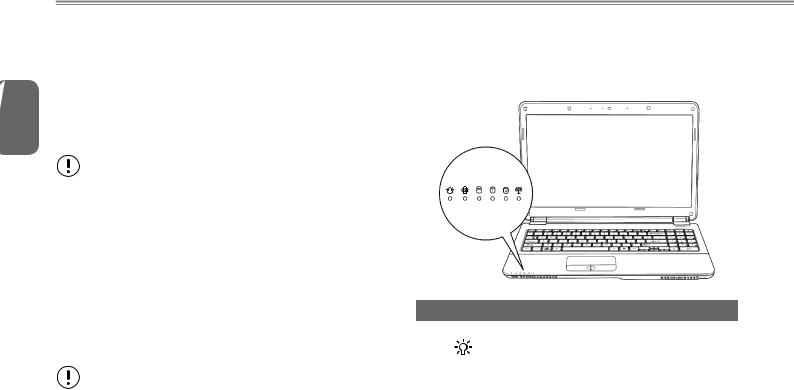
English
10
2.3 Starting Your Notebook
Suspend / Power on Button
The suspend/power on switch is used to switch on your notebook from its off state. Once you have connected your AC adapter or charged the internal Lithium-Ion battery, you can power on your notebook by pressing the suspend/power on button located above the keyboard. If you need to take an extended break, press the button again to place the notebook into sleep mode or turn it off.
CAUTION: Do not carry your notebook around with the power on or subject it to shocks or vibration, as you risk damaging the hard disk.
When you power on your notebook, it will perform a Power On Self Test (POST) to check the internal parts and confguration for correct functionality. If a fault is found, your computer emits an audio warning and/or displays an error message on the display with a description or code.
Depending on the nature of the problem, you may be able to continue by starting the operating system or by entering the BIOS setup utility and revising the settings. After satisfactory completion of the Power On Self Test (POST), your notebook loads the installed operating system.
CAUTION Never turn off your notebook during the Power On Self Test (POST), or an unrecoverable error may occur.
2.4 Status Indicators
The status indicator lights correspond to specific operating modes. These modes are: Power on/ Suspend status, Battery/AC Adapter status, hard Drive Activity (HDD), Num Lock, Caps Lock, and Wireless transmission activity.
|
|
|
|
|
|
|
|
|
|
|
|
|
|
|
|
NO. Symbol Item |
Function |
||||||
|
|
|
|
Power On/ |
This light illuminates when the |
||
1 |
|
|
|
Suspend |
computer is powered on, and |
||
|
|
|
Status |
flashes when the computer is in |
|||
|
|
|
|
||||
|
|
|
|
Indicator |
Suspend mode. |
||

The Battery indicator tells you whether the Lithium-Ion battery is charging or is already fully charged..
●If you are charging your battery, the Battery indicator remains on
2 |
Battery |
even if your notebook is shut off. |
● If there is no battery activity, the |
Indicator |
power adapters are not |
|
|
|
connected, or the power switch is |
|
off, the Battery indicator will also |
|
be off. |
●Batteries subjected to shocks, vibrations or extreme temperatures can be permanently damaged.
|
Hard Disk |
The Hard Disk Drive (HDD) |
|
|
activity indicator tells you whether |
||
3 |
Drive (HDD) |
your internal hard drive is being |
|
Activity |
accessed and, if so, how fast. |
||
|
|||
|
Indicator |
Do not switch off the botebook if |
|
|
|
this light is flashing. |
|
|
|
This indicator shows when the |
|
4 |
The Num Lock internal keyboard is in ten-key |
||
|
Indicator |
numeric keypad mode. |
|
|
|
||
|
|
|
|
5 |
The Caps |
This indicator tells you that the |
|
keyboard is set to type in all capital |
|||
Lock Indicator |
|||
|
|
or uppercase letters. |
|
|
Wireless |
The Wireless Transmission |
|
6 |
Transmission |
Activity indicator tells you whether |
|
Activity |
your computer is connected to a |
||
|
|||
|
Indicator |
Bluetooth/wireless network or not. |
|
Q1585 SERIES USER’S MANUAL
2.5 Using Function Keys
Your computer has 12 function keys, F1 through F12. The functions assigned to these keys differ for each application. You should refer to your software documentation to find out how these keys are used. The [FN] key provides extended functions for the notebook and is always used in conjunction with another key.
●[FN+F1]: Places the notebook in Suspend mode. Pressing the Power button returns it to active mode.
●[FN+F2]: Enables or disables the wireless network connection.
Press this key combination to enable Wireless LAN connection.
●[FN+F3]: Allows you to change your selection of where to send your display video. Each time you press the combination of keys you will step to the next choice. The choices, in order, are: built-in display panel only, both built-in display panel and external monitor, or external monitor only.
●[FN+F4]: Decreases the screen Brightness.
●[FN+F5]: Increases the screen Brightness.
●[FN+F6]: Mutes the computer’s volume.
●[FN+F7]: Decreases the computer’s volume.
●[FN+F8]: Increases the computer’s volume.
●[FN+F9]: Play or Pauses the current/selected multimedia track.
●[FN+F10]: Stop the current multimedia track.
●[FN+F11]: Skip Back to the previous multimedia track.
●[FN+F12]: Skip Forward to the next multimedia track.
●[FN+Esc]: Enables or disables the Bluetooth function.
English
11
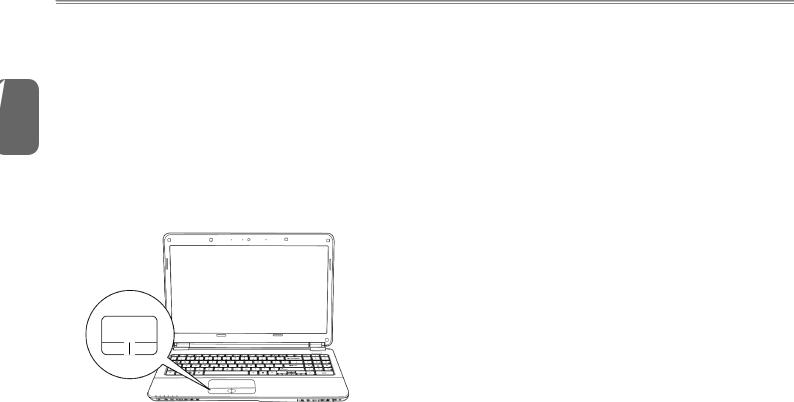
English
12
2.6 Using the Touchpad
A touchpad pointing device comes built into your computer. It is used to control the movement of the pointer to select items on your desktop and use applications on the notebook.
The touchpad consists of a cursor control, a left and right button, and a scroll bar. The cursor control works the same way a mouse does, and moves the cursor around the display. It only requires light pressure from the tip of your finger. The left and right buttons function the same as mouse buttons. The actual functionality of the buttons may vary depending on the application that is being used.
The scroll bar allows you to navigate quickly through pages, without having to use the on-screen cursor to manipulate the up and down scroll bars.
Clicking
Clicking means pushing and releasing a button. To left-click, move the cursor to the item you wish to select, press the left button once, and then immediately release it. To right click, move the mouse cursor to the item you wish to select, press the right button once, and then immediately release it. You also have the option to perform the clicking operation by tapping lightly on the touchpad once.
Double-Clicking
Double-clicking means pushing and releasing the left button twice in rapid succession. This procedure does not function with the right button. To double-click, move the cursor to the item you wish to select, press the left button twice, and then immediately release it. You also have the option to perform the double-click operation by tapping lightly on the touchpad twice.
Dragging
Dragging means pressing and holding the left button while moving the cursor. To drag, move the cursor to the item you wish to move. Press and hold the left button while moving the item to its new location and then release it. Dragging can also be done using the touchpad. First, tap the touchpad twice over the item you wish to move, making sure to leave your finger on the pad after the final tap. Next, move the object to its new location by moving your finger across the touchpad, and then release your finger. Using the Scroll bar allows you to navigate through a document quickly without using the window's scroll bars. This is particularly useful when you are navigat-ing through on-line pages.
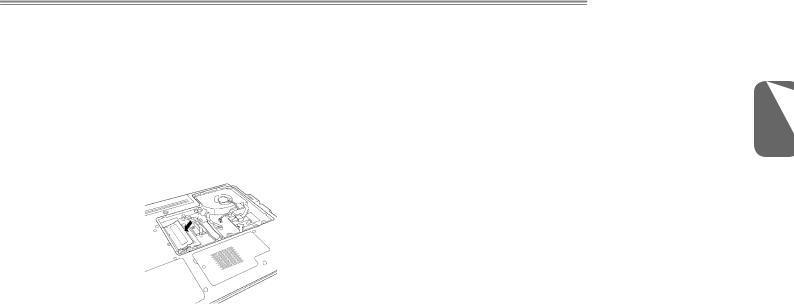
2.7 Memory Module Upgrade
To increase your notebook's memory capacity (up to 8 GB maximum), additional memory modules may be installed. The memory upgrade must be a dual-in-line (DIMM) SDRAM module.
Do not remove any screws from the memory upgrade module compartment except for the ones specifically shown in the directions here.
Installing a Memory Module
The following steps describe how to install a memory upgrade module. We do not recommend that you do this yourself.
1.Turn off power to your notebook using the power switch, disconnect the power adapter, and/ or remove the battery pack.
2.Place your notebook upside-down on a clean work surface.
3.Loosen the five screws securing the compartment cover.
4.Lift up and remove the compartment cover. The memory upgrade module can be severely damaged by electrostatic discharge (ESD). Be sure you are properly grounded when handling and installing the module.
5.Align the connector edge of the memory upgrade module, chip side up, with the connector slot in the compartment.
Q1585 SERIES USER’S MANUAL
6.Insert the memory upgrade module at a 45o angle and press it firmly onto the connector.
7.Press the memory upgrade module down into the compartment until it locks into the retaining clips on either side. You will hear a click when it is properly in place.
8.Replace the cover and screws that were removed previously. Installation of the new memory module is now complete.
The memory upgrade module is not something you routinely remove from your notebook PC. Once it is installed, you should leave it in place unless you want to increase system memory capacity.
English
13

English
14

Q1585 SERIES USER’S MANUAL
Chapter 3 GIGABYTE
Smart Recovery
English
15
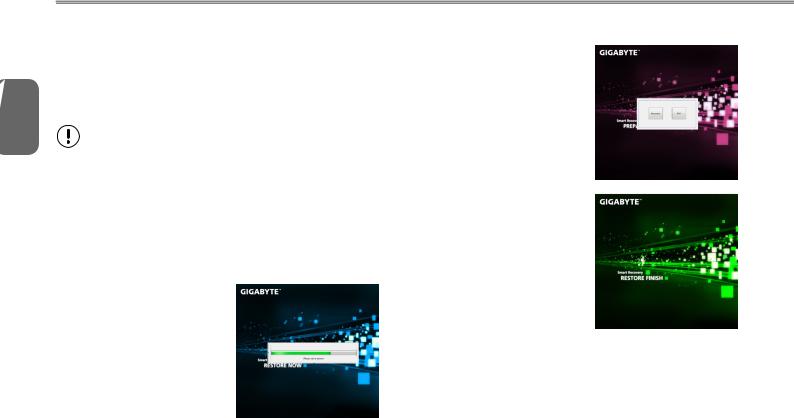
English
16
3.1 GIGABYTE Smart Recovery
System Recovery - Restore your Q1585 operating system. The hard drive of the Q1585 has a hidden partition that contains a full backup image of the operating system that can be used to recover the system in the event that something happens to the operating system.
If the hard drive is removed or the partition deleted, the recover options will no longer be available and a recovery service will be needed.
Launch System Recovery
The system recover feature is part of the netbook installation and it ships preset from the factory. The options menu allows you to launch the Windows recovery tool to reinstall the operating system to factory defaults.
Below will briefly describe how to launch the recovery tool and to get the recovery started.
1.Turn off or restart the netbook. 2.Turn the netbook on and press and hold the F9 key to launch the
tool.
3.The recovery window will open and give you the option to "Recovery" in the toolbar. You will be prompted if you want to recovery. Click on "Recovery" to begin the repair if you do.
4.The "Recovering" window will open and begin the recovery.
5.Once it is complete you will be prompted to reboot the netbook.

Q1585 SERIES USER’S MANUAL
Chapter 4 Troubleshooting
This section will briefly cover some frequently encountered problems and questions and provide a quick guide to assist with solve these problems. Most problems can be resolved quickly, simply and easily and are not always a system problem. Should you encounter a problem that is not yet or differently listed, please consult the GIGABYTE website or call your unit supplier for assistance.
For website assistance go to the Support section of www.gigabyte. com for telephonic assistance please call the supplier of your unit or take the unit to the supplier directly for assistance.
English
17

English
18
Troubleshooting
Your notebook PC is sturdy and subject to few problems in the field. However, you may encoun-ter simple setup or operating problems that you can solve on the spot, or problems with periph-eral devices, that you can solve by replacing the device. The information in this section helps you isolate and resolve some of these straightforward problems and identify failures that require service.
4.1 Identifying The Problem
If you encounter a problem, go through the following procedure before pursuing complex troubleshooting:
1.Turn off your notebook.
2.Make sure the AC adapter is plugged into your notebook and to an active AC power source.
3.Make sure that any card installed in the PC card slot is seated properly. You can also remove the card from the slot, thus eliminating it as a possible cause of failure.
4.Make sure that any devices connected to the external connectors are plugged in properly. You can also disconnect such devices, thus eliminating them as possible causes of failure.
5.Turn on your notebook. Make sure it has been off at least 10 seconds before you turn it on.
6.Go through the boot sequence.
7.If the problem has not been resolved, contact your support representative.
●Product name
●Product configuration number
●Product serial number
●Purchase date
●Conditions under which the problem occurred
●Any error messages that have occurred
●Hardware configuration
●Type of device connected, if any
See the configuration label on the bottom of your notebook for configuration and serial numbers.
Copyright-protected technology This product incorporates copyright protection technology that is protected by U.S. patents and other intellectual property rights. Use of this copyright protection technology must be autho-rized by Macrovision, and is intended for home and other limited viewing uses only unless otherwise authorized by Macrovision. Reverse engineering or disassembly is prohibited.
4.2 GIGABYTE Service Information
Before you place the call, you should have the following information ready so that the customer support representative can provide you with the fastest possible solution:
More service information please link to GIGABYTE official website: www.gigabyte.com

Appendix
Q1585 SERIES USER’S MANUAL
English
19
